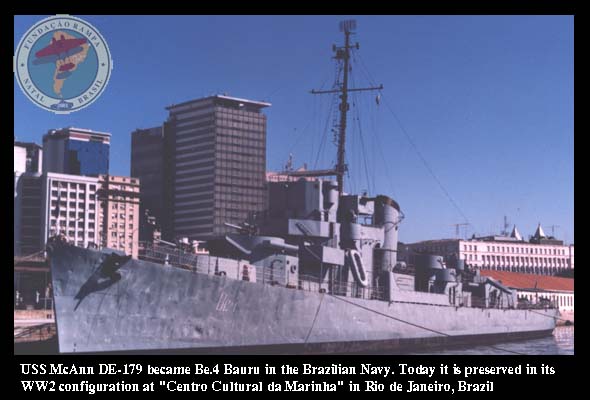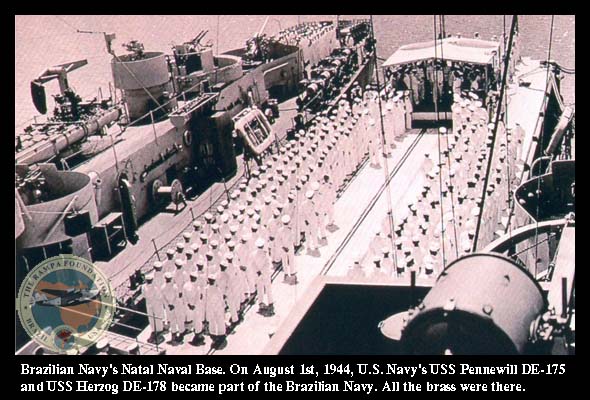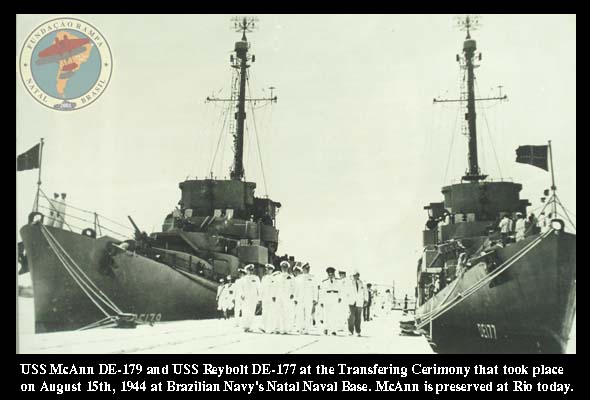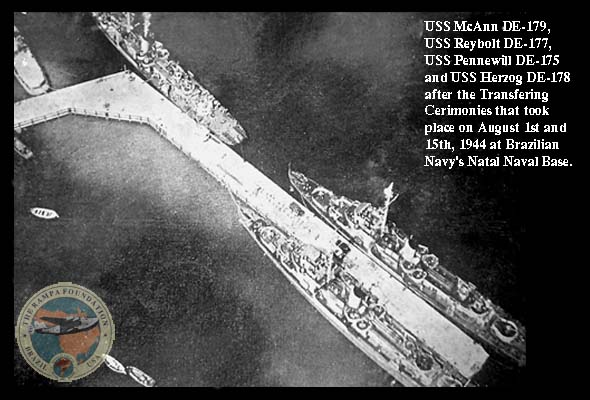
U.S. Navy Escort Destroyers handover
Brazilian Navy received them




Brazilian Navy entered WW2 in a desperate situation. Old ships, old techniques, its planes being transfered to the newly-created Brazilian Air Force.
Who to turn to in order to get new vessels? The U.S. Navy. At the begining, the Americans did not have spare ships to give away, so Brazilian Navy had to wait and in the meantime U.S. Navy was taking charge of South Atlantic defense.
Main tasks were convoy coverage and protection and Anti Submarine Warfare, ASW. With both surface ships and aircrafts (planes and blimps) U.S. Navy bore the brunt of the Atlantic Battle with the British, being the Brazilians a small part, due to its dispreparedness and poor equipment. It was time to learn, and that was what the Brazilians did, and in 1944 the U.S. Navy began handing over some of their Destroyer Escorts.
Brazil had built a new Naval Base in Natal, in 1941-2, but had no ships. Adml. Ary Parreiras, the Base builder and Commander complained about it to Brazilian President Vargas, when the latter came to Natal in Jan, 1943. The President asked to Parreiras what he needed, the answer was: "ships, ships, ships". What Vargas could do? Not much. According to Parreiras, it was feared that once Brazil got its ships and the threat was over, Brazilian Navy would recover its ships to the harbor, and not help the U.S. in patroling the Atlantic. Parreiras was also sick about not having ships to send the Brazilian Expedicionary Force to Europe, having to rely on the Ally. Even ships to protect the transport ship carring the Brazilian Army would do. Something to boost the National Ego. Brazilian defense was being made by a foreign country. Parreiras could not stand this.
The year of 1944 came with the feeling that the Allies would win the war, production of war material was bigger than needed and the Brazilians were now well-trained and could defende themselves, so ships used in Brazilian waters and belonging to the U.S. 4th Fleet begin to be transferd to the Brazilian Navy.
One can imagine Parreiras feelings of relief when he knew about the ships, specialy because the cerimony of transfer would take place at his Base. Natal Naval Base. His beloved base, that now stands his name.
It was the first of August, 1944 when USS Pennewill DE-175 and USS Herzog DE-178 became part of the Brazilian Navy under the lend-lease Act, being definetively transferd after the war. The Commander could not be happier. Adml Ingram himself and all military and civil leaders in Natal came to the cerimony. it was a day of joy.
Carl D. Dustin remembers very well his old ship, he served abord Herzog from the day she was commissioned on October 2, 1943 till the day she was transfered to the Brazilian Navy. Herzog made several convoy and hunter-killer duties. She crossed the Equator 14 times from Port-of-Spain, Trinidad to Recife, Brazil. After the handover the former crew went to Parnamirim Field and took a plane back to the States. Mr. Dustin is a Contributor of the Rampa Foundation and lives in California.
More was to come, on the 15th August, 1944 USS Reybolt DE-177 and USS McAnn DE-179 were also handed over to the Brazilian Navy.
November 19th saw USS Cannon DE-99 and USS Christopher DE-100 change flag. The last ones were USS Alger DE-101 on March10, 1945 and 10 days later, USS Marts DE-174.
Another Destroyer Escort, DE-182 USS Gustafson was also in Brazilian waters, although not transfered to Brazil. According to Art Libecki, who was a Plank-owner, meaning he was aboard when the ship was commissioned in the Brooklyn Navy Yard in late '43, the shakedown was in Bermuda and the next duty was in Brazil, 1944. They operated from four Brazilian ports, Recife, Bahia, Rio de Janeiro and Rio Grande. He was Baker 1/c and they had 62 consecutive Renions of the shipmates since the end of the war. He lives in Michigan and is also a Contributor of the Rampa Foundation.
We thank the DESA - Destroyer Escort Sailors Association for puting those sailors in contact with us.
By now Brazilian Navy was taking charge of significant part of patroling South Atlantic waters along the U.S. and British Navies. U-boat threat was over.
It was time to finally escort the transport ship that went to Italy with the Brazilian Expeditionary Force (FEB) in its belly. The first and second trips were escorted by the Americans only. It began in July, 1944.